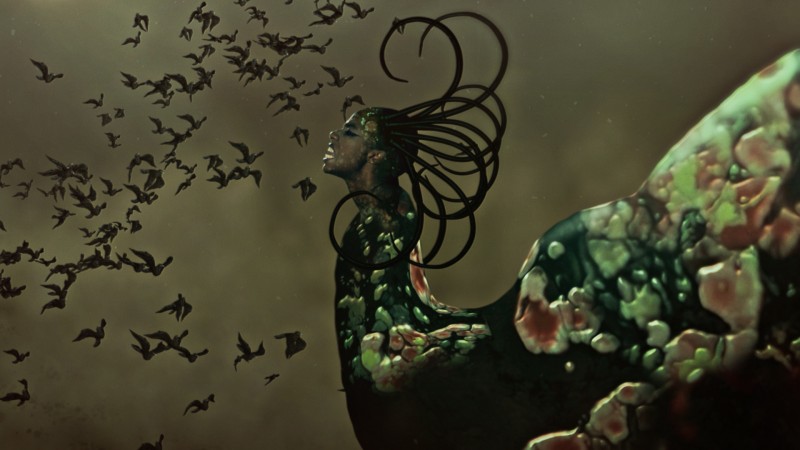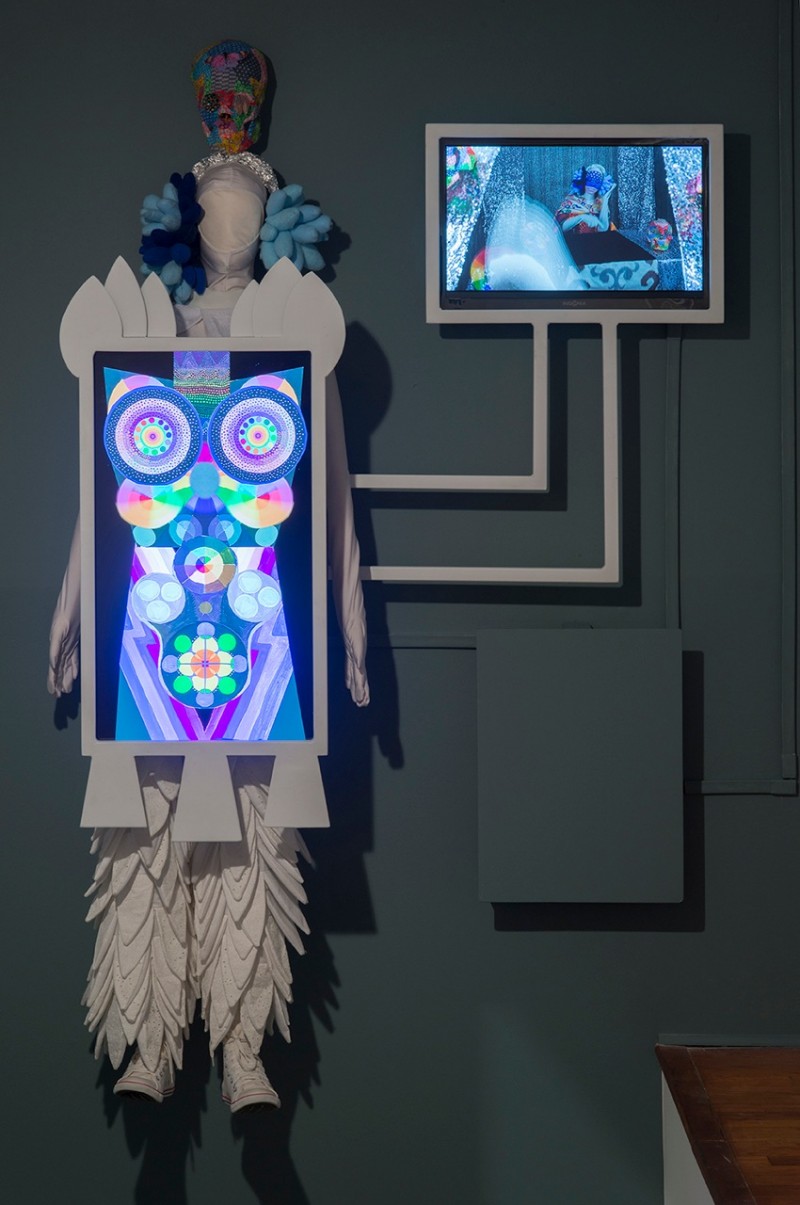For the online research project Liquid Blackness, Alessandra Raengo reflects on Harry Elam’s assertion that in contemporary culture, blackness is able to “travel on its own, separate and distinct from black people.”1 Raengo writes that the detachability of blackness from black subjectivity, identity, and history “remains exceedingly attractive and possible” in mainstream society and that this detachment opens up possibilities for artists.2 Art exhibitions such as Nicola Vassell’s Black Eye leverage contemporary forms of mobility in blackness. Vassell states,
A black eye is our true tool—it’s the thing a lot of us rely heavily on for this art world to even exist… But at the same time, a black eye is the document of having been bruised.3
Artists who trouble notions of blackness include Wangechi Mutu, Jacolby Satterwhite, Sanford Biggers, Hank Willis Thomas, Rashid Johnson, Kerry James Marshall, and Wanuri Kahiu, who made Kenya’s first science-fiction film, Pumzi. These artists visualize the creative and symbolic dimensions of the future in ways that also resonate in the texts of black science-fiction writers such as Octavia Butler. In “The Intuition of the Future: Utopia and Catastrophe in Octavia Butler’s Parable of the Sower,” Jerry Phillips quotes Lewis Mumford’s idea of the author (or artist) as the creator. Mumford asserts that “the writer is still a maker, creator, not merely a recorder of fact, but above all an interpreter of possibilities.”4 Phillips further elaborates,
By exploring “possible worlds” and “intuitions of the future” that critique the present…the [artist] recovers purposive human time, the sense that history is not something that simply happens to us, irrespective of our will and desires, but is, indeed, ours to make.5
In her essay “Race as Technology,” Beth Coleman provides a foundation for the social imaginary that moves race and gender away from the “biological and genetic systems that have historically dominated its definition and toward human agency.”6 Coleman offers a view of race that exists as if it were on par with an instrument, as a technology or system that is “denatured from its historical roots” and “freely engaged as a productive tool.” This is different than, for example, the Wachowski brothers’ Matrix films that envisioned a futuristic world in which machines rule and use humans as slaves. Butler’s Parable of the Sower and Kahiu’s Pumzi convey visions of the future where people are slaves or enabled to leave their walled-in communities.

Wangechi Mutu. The End of eating Everything, video still, 2013. Animated video, color, sound; 8:10 minutes. Courtesy the artist, Gladstone Gallery, and Victoria Miro Gallery. Commissioned by the Nasher Museum of Art at Duke University, Durham, North Carolina.
Contemporary black artists often refute conventional notions or images of blackness and replace them with altered realities. Their works exist in the social imaginary between the symbolic and the real—avatars with alternate, hybrid, or cyborg identities, surrounded by worlds that stimulate the viewer’s awareness of the future. Wangechi Mutu’s video The End of eating Everything features the head of the musician and singer Santigold consuming flocks of black birds. Slowly, the frame expands to reveal a massive “she-planetoid, comprising writhing limbs and embedded, useless machinery, powered by her/its own gaseous effluent.”7 Mutu’s collage Agave you portrays an encounter between a tree and a female pseudo-cyborg whose tentacles take root in the earth. In Pumzi, the character Asha, more scientist than cyborg, escapes enslavement and ecological devastation by sacrificing her body to grow a germinating seed.
Returning to Coleman’s “race as technology”—denaturing race from historical references—and futuristic expressions of style, rhythm, dance, and the body in art, we can see the formation of a social imaginary that disrupts the syntax. In Reifying Desire 6, a video installation presented at the 2014 Whitney Biennial, Jacolby Satterwhite explores the narratives of his queerness in a surreal universe, mixing 3-D animation, digital drawings, and footage of himself performing in a spandex bodysuit and sculpted headpiece. “I wanted a gestation-cycle video where I get impregnated and give birth to a new language system,” Satterwhite says. “All these elements create a friction, a thunderstorm.”8 Saya Woolfalk’s ChimaTek™ demonstrates the workings of a synthesizing, hybridizing machine that remixes identities to create hybrid human-plant creatures.

Saya Woolfalk. ChimaTEK: Hybridization Machine, 2013. Natural and synthetic fabric, foam mannequin, painted steel, converse shoes, plastic skull, glass and plastic beads, two television monitors, electronics; 74 wide x 82 high. Courtesy the artist.
In “Du Bois’s Ambient Poetics: Rethinking Environmental Imagination in The Souls of Black Folk,” Anne Raine notes how nature is central to the articulation of the “spiritual world” in which African Americans live and strive. According to Raine, W. E. B. Du Bois’s main concern is “not to foster attention to and concern for nonhuman nature, but to explore the strange meaning of being black.”9 In the twenty-first century, contemporary black artists are very much connected to nature. The movement of the body in space draws one’s attention to nature, to what normally goes unnoticed as background—as in ambient music and light, for example, or as in the poetics of race and place. In Hycide magazine’s video Black Magic, the dancer Storyboard P pops, twirls, and contorts his body in the light. Moon Medicin, the conceptual band and dream child of Sanford Biggers convenes to concoct a fuel elixir for inter-dimensional travel and perceptual shifts.10
Moon Medicin at the David Rubenstein Atrium at Lincoln Center, Frieda and Roy Furman Stage, New York, NY, 2014.
Black futurism as a form of creative expression pushes against the conventional limits of black subjectivity. As seen in the works highlighted here, this mobility of blackness gives artists agency to freely engage in the processes of reattachment, immersion, or movement in the universe.





Pingback: Black Futurism: The Creative Destruction and Reconstruction of Race in Contemporary Art | ART21 Magazine | Monique Charles
Pingback: exiting | double sense of vision
Pingback: Moving on the Wires: Recent News and Posts | Aker: Futuristically Ancient
Pingback: Article: Black Futurism: The Creative Destruction and Reconstruction of Race in Contemporary Art | Art History Ramblings
Pingback: Black Futurism: The Creative Destruction and Reconstruction of Race in Contemporary Art - 1-954-270-7404
Pingback: #Hashtags: Black Futurism: The Creative Destruction and Reconstruction of Race in Contemporary Art | Nick Socrates
Pingback: Using STEAM to Move Marginalized Students into the Future: An Interview with Dr. Nettrice Gaskins - Blerds